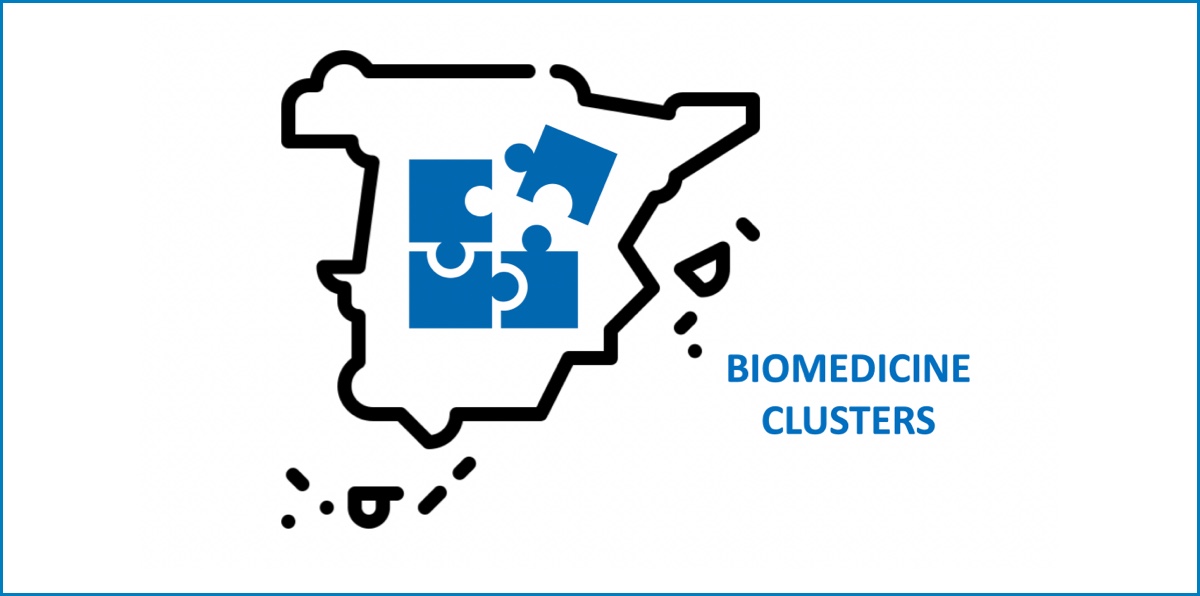29 Apr The growth of Clusters in the field of Biomedicine in Spain

• Clusters are geographical or sectoral groupings of relevant actors to collaborate, innovate and promote economic and scientific development.
• Associations of companies in biomedicine, the creation of public-private foundations in the field of health innovation to promote geographical areas, as well as public aid to them, are some of the factors, among others, that have contributed to the growth of the clusters.
• A pending issue would be the creation of greater synergies between the different regional clusters.
Biomedicine innovation clusters in Spain reflect the rich diversity and accelerated growth in this crucial field for health and the economy. These clusters are geographical or sectoral groupings that bring together companies, research centres, universities and other relevant actors in a specific area, in this case biomedicine, to collaborate, innovate and promote economic and scientific development.
Sometimes, in our health sector, cluster terminology can be confused with the concept of Bioregion. This occurs mainly in highly evolved clusters that encompass practically all stakeholders in the same ecosystem, including other smaller clusters.
Among the main causes of the growth of clusters in Biomedicine we can point to:
1-The associations of companies created in the biomedicine or biotechnology sector, which may also incorporate research institutions and universities. The main objective of these groupings/associations is to boost the economic development and competitiveness of the companies that are part of them, as well as to promote innovation and sustainable growth in the biomedicine sector. There are numerous such associations in Spain. The main association at national level is ASEBIO, created in 1999. This association shows the important impact that biotech companies have on our country’s GDP, as indicated by the data in its reports. As an example, in the 2022 report, the GDP of biotech companies in 2021 amounted to 11,183 million euros, representing 1% of GDP and employing 118,000 people. At regional level there are also many associations and many of them are playing a relevant role. Among them we can highlight: Cataloniabio, Bioval, Bioga, Basque HealthCluster, Navarra Health Cluster etc.
2- Public-private foundations in the field of Health and innovation to boost Bioregions. These foundations seek to identify the needs of the Bioregion and implement a strategy and action plan that aims to maximise the economic and social impact of the life sciences and innovation ecosystem in that region. To achieve this goal, they carry out various training, acceleration activities, internationalisation support, etc. These include: Biocat, Madri+d, Fundación Progreso y Salud, etc.
3-Investments in cutting-edge research infrastructures and in business associations. European and national funds intended for research and innovation have played a very important role in this matter. Specific public aid has also emerged to support innovation from business associations, such as that offered by MINCOTUR. One of the lines supports actions for the operation of these Innovative Business Associations (AEI) and another line finances technological developments promoted by companies that form part of these clusters, with the intervention of the AEI in work packages such as coordination/management/communication.
4- Transfer Units in Universities and Research Support Units in Hospitals, as well as technology transfer support programmes, have provided the necessary resources to boost the development of biomedicine in Spain. These Units are responsible for acting as antennae for the ideas generated within their environment and for transferring the results of their own research, either by creating a spin-off or by licensing results to the private sector, mainly to national or international companies in the pharmaceutical or biotech sector.
5-The creation of highly qualified human talent. The existence of a wide network of universities and research centres has facilitated the generation of knowledge and the training of professionals in the field of biomedicine.
6-The attraction of national and foreign talent through aid programmes that offer funding and support to researchers of any nationality and scientific discipline to develop their research activity. Among these programmes, which have been developed by Autonomous Communities with great success, the following stand out: ICREA or Ikerbasque. There are also initiatives of this type aimed at retaining talent at national level, such as the Ramón y Cajal Programme, the Juan de la Cierva Programme, the Torres-Quevedo Programme, etc.
7- The attraction of national and foreign investment has also contributed to the growth of these clusters, with public instruments such as CDTI (Centre for Technological Development and Innovation) INNVIERTE also playing a very important role. According to ASEBIO’s 2022 report, Spanish biotechs attracted 142 million euros in investment in 2022.
8- Participation in international research and collaboration networks, as well as the organisation of international events and conferences, have increased the visibility and prestige of Spanish biomedicine at a global level.
In conclusion, biomedical innovation clusters in Spain represent a successful example of the promotion of research, innovation and economic development in a strategic field for the health and well-being of society. The combination of highly qualified human resources, state-of-the-art research infrastructures and an environment conducive to scientific and business collaboration has boosted the growth and competitiveness of Spanish biomedicine at national and international level. However, perhaps a pending issue is the creation of greater synergies between the different regional clusters. These synergies would allow an exponential increase in our capacities to turn biomedicine into one of the main drivers of our economy.
| Main causes of the growth of clusters in Biomedicine |
| Business associations |
| Public-Private Foundations in the field of Health to boost clusters |
| Investments in state-of-the-art research infrastructures and in business associations |
| Transfer Units in Universities and Research Support Units in Hospitals |
| The creation of highly qualified human talent |
| Attracting national and foreign talent |
| Attracting national and foreign investment |
| Participation in international collaborative networks, international congresses, etc. |


